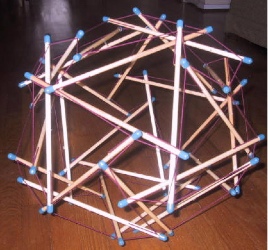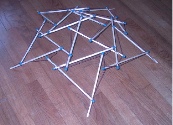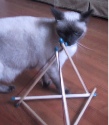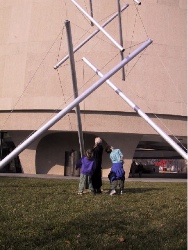Quick Links
Advertisements
No ends building toy
Great geeky toys
Categories
Archives
XML/RSS Feed
Statistics
Total entries in this blog:
Total entries in this category:
Published On: Nov 13, 2009 08:19 AM
Total entries in this category:
Published On: Nov 13, 2009 08:19 AM
Related websites
Geometric Toy
Supermagnetic Polyhedra
Architectural Toys
Zomeworld (list)
Polytopia (list)
Math Toys Community at Orkut (requires invitation to join orkut - e-mail me to request one)
Supermagnetic Polyhedra
Architectural Toys
Zomeworld (list)
Polytopia (list)
Math Toys Community at Orkut (requires invitation to join orkut - e-mail me to request one)
Tensegritoy
 This Tensegitoy kit contains thirty slotted and
drilled wooden dowels, thirty brass tipped elastics, and sixty-four caps. It can
be used to make an assortment of different polyhedrons and other shapes,
according to the principles of tensegrity, with the sticks serving as
compression elements, while the elastics provide the tension. For those who
yearn to do more than this kit allows, there are extender and bulk kits,
containing 60 and 180 sticks, respectively. The cost is rather high, at nearly a
dollar per dowel. On the other hand, the kit's clearly-written and carefully
illustrated instructions are invaluable, and making your own requires more initiative than
most of us have. (George Hart has an easier tensegrity structure project using soda straws.)
At the least, using the kit first gives you a better feel for how to work with
tensegrity.
This Tensegitoy kit contains thirty slotted and
drilled wooden dowels, thirty brass tipped elastics, and sixty-four caps. It can
be used to make an assortment of different polyhedrons and other shapes,
according to the principles of tensegrity, with the sticks serving as
compression elements, while the elastics provide the tension. For those who
yearn to do more than this kit allows, there are extender and bulk kits,
containing 60 and 180 sticks, respectively. The cost is rather high, at nearly a
dollar per dowel. On the other hand, the kit's clearly-written and carefully
illustrated instructions are invaluable, and making your own requires more initiative than
most of us have. (George Hart has an easier tensegrity structure project using soda straws.)
At the least, using the kit first gives you a better feel for how to work with
tensegrity.


The simplest model we made was an approximation of a simple tetrahedron, or perhaps we should say truncated tetrahedron, since the ends of the struts do not quite meet, but instead form triangles. The model pictured at the top is the tensegrity version of an icosahedron, with pentagonal spaces at the vertices.

Tensegrity models are more difficult to construct than most designs from the geometrical modeling kits reviewed in this weblog. This kit is marked for ages ten through adult, but might be questionable for the lower end of that range.
Check out this link to the Needle Tower, which is a wonderful example (shown only partially in the family snapshot on the right) of a tensegrity tower at the Hirshhorn museum in Washington, DC. It looks as though about 36 enormous aluminum sticks of gradually decreasing size were required to build it. It is wonderful to stand under the tower and look up at the regularities of the structure. This sculpture was created by Kenneth Snelson, who first invented tensegrity structures in 1948. (The word tensegrity was coined by Buckminster Fuller.) The nature of elastic means that our toy will age and lose its stretch within a few years, but the stainless steel cables used by Snelson last far longer.
Posted: Mon - January 3, 2005 at 08:19 PM